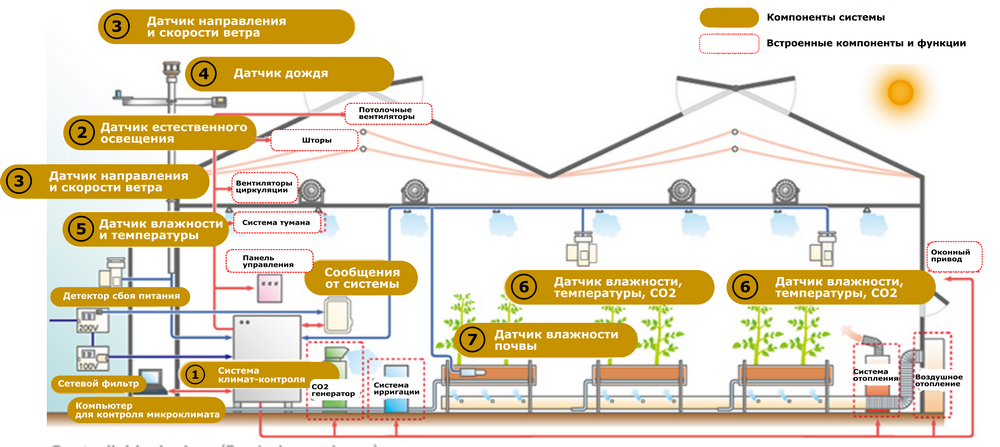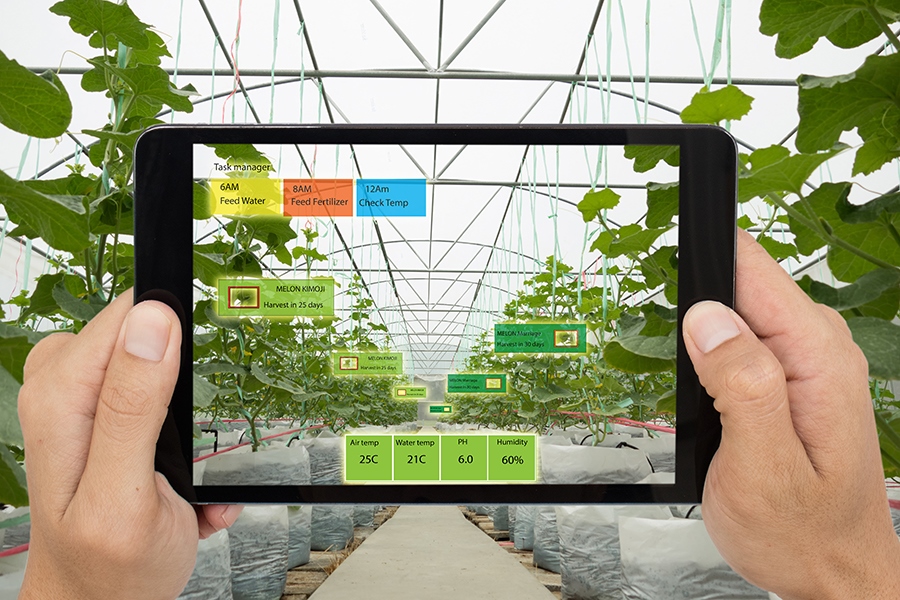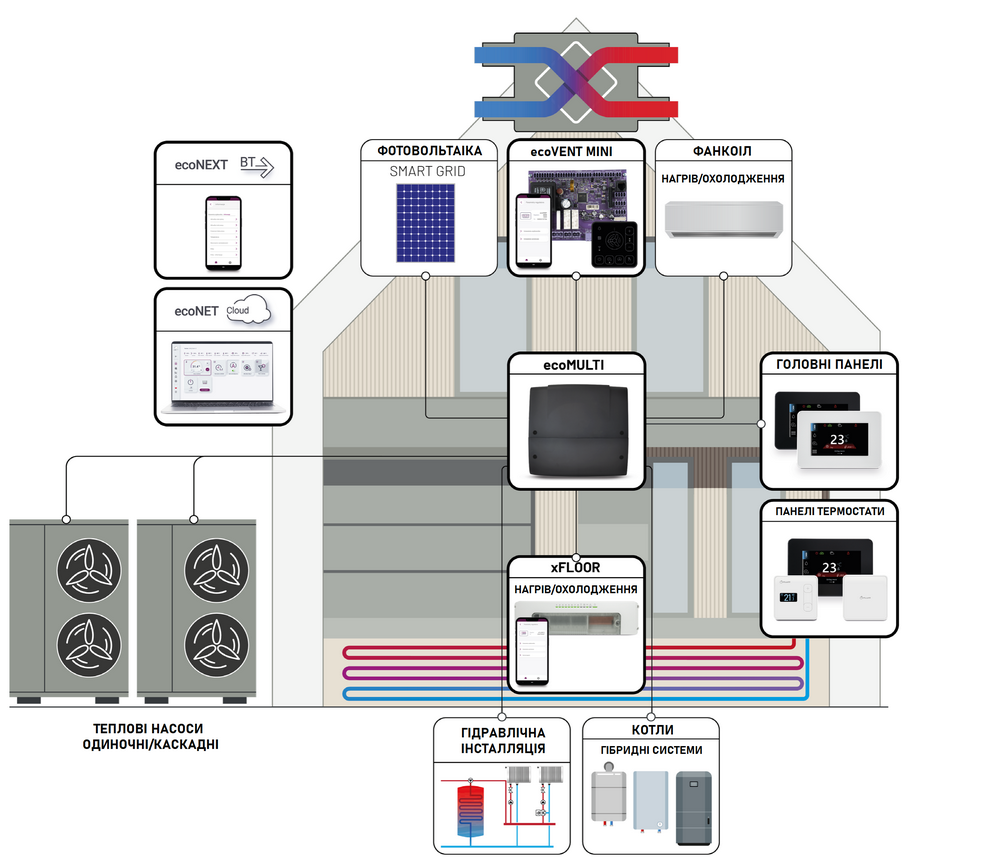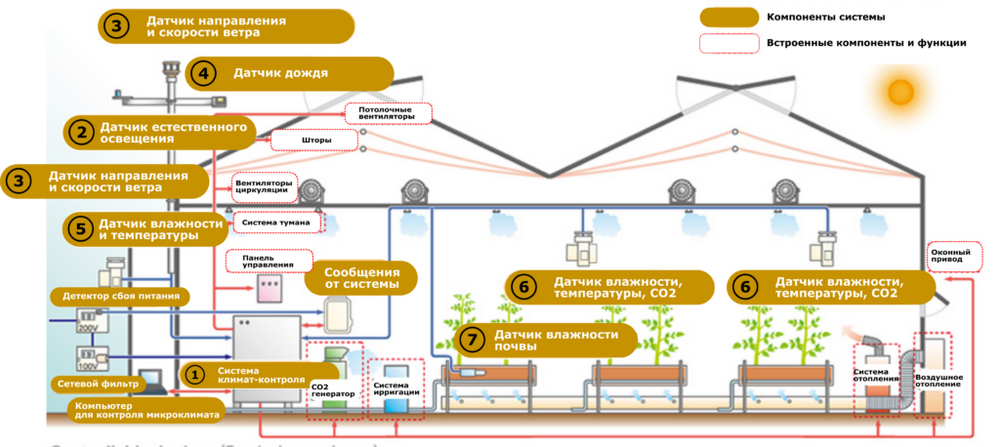What kind of heating is there in greenhouses: all-season and seasonal versions
When you wonder what kind of heating is used in greenhouses, you should always look for the answer within the concept of climate control. It follows the basics of HVAC, which means ventilation, heating, cooling, humidity and lighting control. Taking into account what specific type of greenhouses we are talking about, a specific design solution is built.
Our company offers automation of greenhouses based on the FOCUS pellet boiler room and the PLUM programmer, which allows you to connect climate control. Of course, we are talking about all-season permanent buildings. If you want to make a seasonal greenhouse, then it is better to opt for heated floors on a solar system on the roof, and also use a fog system for cooling and irrigation, which we also have in stock.

What does a greenhouse climate system include?

A greenhouse climate system includes several components that work together to create optimal growing conditions for plants in the greenhouse environment. Here are the main components of a greenhouse climate system:
- Ventilation. Good ventilation in a greenhouse is essential to ensure air circulation and humidity control. Ventilation windows or vents are usually located on the roof and/or sides of the greenhouse. They can be automatic and respond to changes in temperature and humidity, opening or closing according to preset parameters.
- Heating. As mentioned, a heating system is used to maintain an optimal temperature in the greenhouse, especially during the colder months or at night. What kind of heating is there in greenhouses? Electric fan heaters, hot water heaters, radiator heating and water-based air heating are used. The energy source used is electricity, gas, steam (for large complexes) or solar energy.
- Cooling. On hot days, the greenhouse may become too hot, which can negatively affect the plants. Cooling systems such as fogging systems, fans or air conditioners. They help reduce the temperature and maintain comfortable conditions in the greenhouse.
- Humidity control. Controlling humidity in a greenhouse is important to prevent the development of fungal diseases and mold growth. Air enrichment systems or even humidifiers can be used for this.
- Lighting. In some cases, lighting may also be included in the greenhouse's climate control system, especially during periods of limited sunlight. This may include the use of artificial lighting to extend the daylight period.
- Monitoring CO2 levels. It is known that plants need carbon dioxide to develop, while in the process of photosynthesis they synthesize oxygen. On closed ground, there may be a lack of carbon dioxide, which negatively affects agricultural crops.
An effective greenhouse climate system must be well-balanced and automated to provide optimal conditions for plant growth and development throughout the year.
Climate control in the greenhouse
Climate control in a greenhouse is organized through a set of systems and techniques aimed at regulating temperature, humidity, ventilation, and sometimes even lighting to create optimal conditions for growing plants. Here are the key components of greenhouse climate control:
- Greenhouses typically have ventilation systems, including roof fans, side fans, or fans, to regulate air flow and temperature within the structure. Ventilation helps prevent overheating on sunny days and ensures proper air circulation for plants
- Greenhouses often use heating systems to maintain the required temperature, especially during cold weather or at night. Common heating methods include gas heaters, electric heaters, hot water pipes, or underfloor heating systems;
- In hot climates or during the summer months, cooling systems are necessary to prevent excessive heat inside the greenhouse. Cooling methods may include shade cloth, evaporative cooling systems, misting systems, or even air conditioning units;
- Controlling humidity levels is critical to preventing fungal diseases and ensuring optimal plant growth. Greenhouses may use humidity sensors and automatic fogging systems to maintain desired humidity levels or dehumidifiers to reduce excess moisture.
- Although natural sunlight is the primary source of light in greenhouses, supplemental lighting may be required, especially during short winter days or in regions with limited sunlight. Artificial lighting systems such as LED or high-pressure sodium (HPS) lamps can extend the photoperiod and provide additional light for plant growth.
- Many modern greenhouses use automated climate control systems that combine sensors, actuators and controllers to monitor environmental conditions and adjust heating, cooling, ventilation and irrigation systems accordingly. These systems help optimize resource utilization and minimize manual intervention.
Generally, effective climate control greenhouses require a well-designed system that balances heating, cooling, ventilation, humidity and lighting to create the ideal environment for plant growth throughout the year. This approach is brought together by the acronym HVAC. It is important for greenhouse operators to regularly monitor the environment and make necessary adjustments to ensure the health and productivity of their crops.
HVAC FOCUS concept for greenhouses: what greenhouse heating is like in practice
This approach is to create optimal climatic conditions based on FOCUS pellet technology. In many ways, they reflect the classical approaches to organizing a microclimate control system in greenhouses, described above. We offer a practical solution for creating a three-circuit heating system: heated floors, radiator circuit and air heating, operating from one source of inexpensive heat, as well as cooling systems based on fogging.
Sensors needed to monitor other climate parameters can be connected to the PLUM HVAC system. The digital control layer combines functional elements with control via a website and mobile application.







